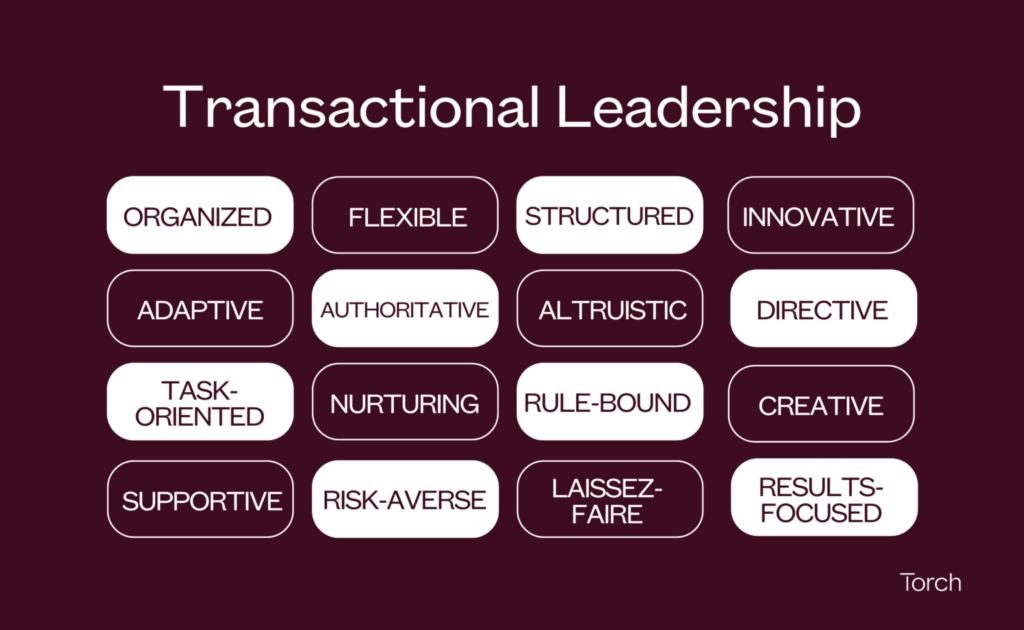When we think of great leaders, we often picture individuals who are empathetic, self-aware, and inspiring. This is why transactional leadership gets a bad reputation.
However, there’s no “right” or “wrong” leadership style — in fact, it’s common for leaders to employ multiple styles. Transactional leadership is one style that, when employed in the right contexts, can give teams the necessary structure, stability, and order to succeed.
Here, we’ll delve deeper into transactional leadership, explore when to use this style, discuss how to become a transactional leader, and compare it to other leadership styles.
What is Transactional Leadership?
Transactional leadership is characterized by control, organization, and short-term planning, relying on a system of rewards and punishments to motivate followers.
Transactional leadership can be appropriate in several contexts and is most effective when:
- Followers are motivated by rewards and punishments
- Followers need to be monitored to ensure they meet performance standards
- The primary goal for followers is to adhere to the leader’s instructions

The Origin Story
A 20th century sociologist named Max Weber was the first person to describe the idea of transactional leadership, which was originally referred to as rational-legal leadership. This leadership style was widely used after World War II in the United States, when the government was focused on rebuilding and required a high level of structure to maintain national stability.
In the 1990s, researchers like James McGregor Burns, Bernard M. Bass, Jane Howell, and Bruce Avolio went on to advance Weber’s theory on Transactional Leadership and defined three major dimensions of this style:
- Contingent Rewards: Transactional leaders like to link goals to rewards.
- Active Management By Exception: Transactional leaders actively monitor their teams, anticipate problems, and issue corrective measures.
- Passive Management By Exception: Transactional leaders tend to stay out of the team’s way and only intervene when standards aren’t met or when the performance doesn’t meet expectations.
What Type of Person is a Transactional Leader?
Let’s go through a business example to better understand what this leadership style looks like in action:
The company you work for has been struggling for many years, dealing with everything from public relations debacles to plummeting sales. Thankfully, things have stabilized recently and the organization is trying to rebuild itself. To help, Jamie was brought in as the new CEO and has been tasked with maintaining stability.
Jamie has over two decades of experience running large, multi-million dollar corporations, so she brings expertise in terms of creating structure, processes, and order. Over the next few months, she focuses on making the short-term goals of the company clear to all employees so everyone understands their roles and what’s expected of them in terms of performance.
While Jamie doesn’t get involved in the day-to-day, she actively monitors progress and intervenes as soon as she notices a problem. Jamie is also quick to praise and reward high-performing employees, while issuing performance improvement plans to team members who aren’t meeting expectations.
In the course of a year, Jamie has brought the company back to a stable place – all thanks to her high level of organization and her teams staying focused on the goals that were set for them.
Ready to transform how leaders grow?
When to Use Transactional Leadership [+ Real-World Examples]
Generally speaking, this type of leadership is effective in crisis and emergency situations, as well as for complex projects that need to be carried out in a very specific way. Here’s what those situations could look like in real life:
- Your team was recently given instructions for a complex product launch that need to be followed precisely to ensure a good outcome. Applying the transactional leadership style can be helpful in this situation since it’ll require control, organization, and short-term planning to complete the project in an effective way.
- Your company is dealing with a cybersecurity crisis that jeopardizes the privacy of your customers. Thankfully, the team has an emergency plan ready to go for situations like this. But implementing it will require a leader who can provide stability, carefully monitor the situation, and quickly intervene if things don’t go as planned. This is exactly the type of situation where a transactional leadership style could be immensely useful.
There are also real-life examples of successful transactional leaders. Here are a few to draw inspiration from:
How to Become a Transactional Leader
While the steps to becoming a transactional leader will vary depending on your exact situation and personality, here are a few general guidelines you can follow to help you move in the right direction:
Create structure
Establishing structure is one of the key roles of a transactional leader. This is done by creating processes, systems, and policies to ensure all work can be done effectively by both individuals and groups. Without this level of structure, things can easily fall through the cracks or there can be room for miscommunication.
Make expectations clear
Transactional leadership is all about generating results. That’s why, as a leader who practices this style, it’s critical to make your expectations clear to the rest of your team. Get specific about what you’re trying to achieve, what your expectations around performance are, and what the rewards and consequences will be if they’re not met.
This way, there’s no confusion about what defines success at your organization. In order to ensure the expectations are being understood, transactional leaders tend to lean on tools like performance reviews and one-on-one meetings to measure progress.
Recognize top-performing employees
A transactional leader should be quick to reward high-quality performance. Linking performance to recognition will make it clear to employees and followers the type of outcome that’s expected of them and will motivate them to continue producing impactful results.
On the flip side, a transactional leader also has to be able to do the harder job of managing poor performance. Similar to rewarding positive performance, there has to be clear consequences associated with unmet expectations – this can come in the form of not being considered for promotions, being put on performance improvement plans, or – in the worst-case scenario – can be grounds for termination.
The Difference Between Transactional Leadership and Other Leadership Styles
Let’s compare transactional leadership with other leadership styles, including transformational, servant, and democratic leadership:
Transactional Leadership vs. Transformational Leadership
Transformational leadership excels in environments that require innovation, creativity, and driving long-term change. This is a stark contrast to transactional leadership, which prioritizes consistency, efficiency, and achieving immediate goals.
While transactional leaders use external rewards and punishments, transformational leaders inspire motivation with vision. And while transactional leaders thrive with routine and established norms, transformational leaders encourage flexibility and out-of-the-box thinking.
Transactional Leadership vs. Servant Leadership
As the name suggests, servant leaders focus on serving their people. Unlike transactional leaders, servant leaders believe in nurturing and empowering their followers in order to create a more engaged and motivated workforce. They do this by leading with empathy, committing to the personal and professional growth of their people, and offering support.
Transactional Leadership vs. Democratic Leadership
Unlike transactional leaders, democratic leaders share authority with their followers, encouraging collaboration and participation in decision-making. As a result, followers have more ownership of outcomes. While transactional leadership focuses on meeting short-term goals with a clear structure, democratic leadership emphasizes long-term and strategic thinking, with decisions made collectively.
Wrapping Up
Transactional leadership can be incredibly effective when applied to the appropriate circumstances. Understanding this approach – and being able to compare it to the other leadership styles we explore in our series – will help you become a more well-rounded and adaptable leader.
Whether you decide to implement transactional leadership or a different style of leadership, there are many resources available to help you fine-tune your approach. Everything from coaching to 360-degree assessments are great tools that can better your understanding and application of leadership.
Understanding the strengths and weaknesses of your own leadership style can help you better identify which approach is best for your current role. Check out our ebook, 10 Leadership Styles You Should Know, to learn more about different approaches to leadership and when and how to apply them.
Want to learn more about different approaches to leadership?
Check out our ebook, 10 Leadership Styles You Should Know.










